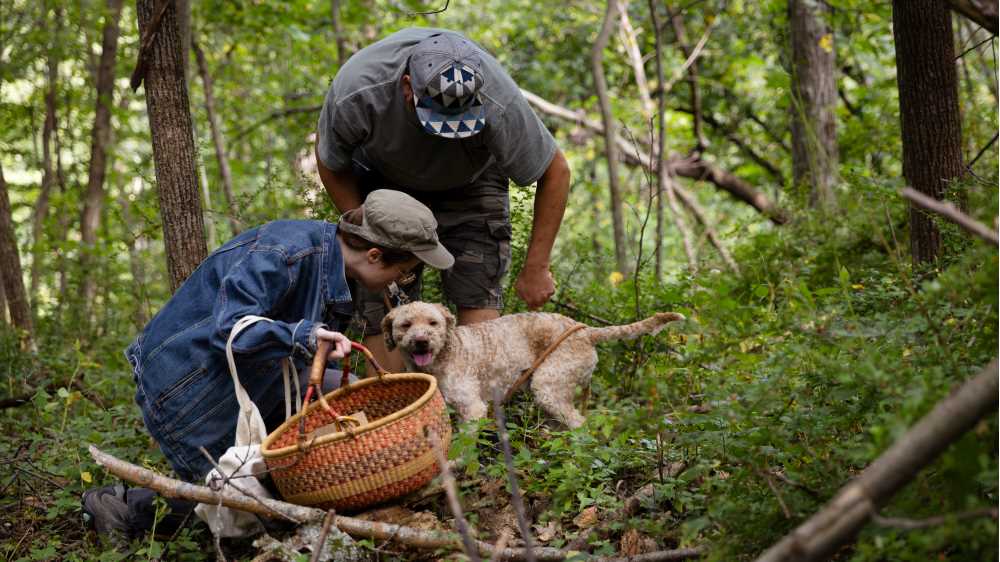Posted 10 a.m. Wednesday, Oct. 22, 2025

UWL researchers explore little-known world of truffles, make exciting discovery
Underground, all across Wisconsin, an entire world of undescribed organisms is waiting to be discovered.
And a small team from UW-La Crosse is leading the way.
Assistant Professor of Biology Arthur Grupe and graduate student Mariah Rogers have been traveling the state to identify, research and document Wisconsin’s population of truffles, a type of underground fungus sometimes found at the base of trees.
Some truffles are prized for culinary purposes and bring significant value when cultivated and co-cropped with economically important host trees.
But in Wisconsin and across much of the world, surprisingly little is known about truffle biodiversity: what species are out there, where they came from, and how they can be used and protected.
“Even seasoned mycophiles who love to forage for fungi, or those of us who go out on forays to document fungal diversity with species lists, do not typically survey for truffles here in the Midwest,” Rogers says. “While there are some researchers already at work in this area, still I would say we barely know what native truffle species we have here.”

Earlier this fall, Rogers and Grupe set out on a truffle-hunting expedition through nine locations in the Coulee Region, on both sides of the Mississippi River. They had a helping paw from Jim, a dog specially trained to sniff out truffles.
But it was a subsequent trip to Bayfield, on the shores of Lake Superior, that produced the most significant finds: more collections of a previously undescribed truffle found growing at the base of a hazelnut tree.
Collaboration with community mycologists led to the initial discovery of this species, with Bayfield resident Arne Martinson having first found the truffles and Rogers collecting more for sequencing and species description in the lab.
In the field, Rogers took photos of the truffles — brown, raisin-sized and dotted with spores — before documenting the coordinates of the discovery and collecting information on nearby trees, soil quality and notable odors.
It wasn’t until the samples were tested and examined in the lab that Rogers and Grupe realized they were dealing with a new species.
“This discovery is exciting for Mariah’s research because, before her collections, this truffle was known from the collections in Quebec- and Oregon-based DNA sequence data,” Grupe explains. “This is a huge range for a single species, and so in addition to formally describing it, it allows us to ask more questions about its biology.

“Where is its natural geographic range? Was it introduced by accident via human movement of hazelnuts around the country for agriculture? Why haven’t we found more collections of it in neighboring states like Minnesota?”
Currently, Rogers is working to sequence additional regions of the truffle’s genome to learn more about how it compares to other species. She looks forward to working with Grupe and her thesis committee to further define its properties and origins, and to give it a proper scientific name.
It's no small achievement for someone who admits she knew little about mycology “beyond the basics of baker’s yeast” as she was finishing up her undergraduate studies. Now, after being drawn in through a capstone project on fungi and getting involved with the Wisconsin Mycological Society, she is hooked.
After completing her master’s at UWL, she hopes to go on to a doctoral program and continue studying fungi. Ultimately, she aspires to a career in mycology — whether as an educator, researcher, museum curator or some combination of the three.
As for her discovery, Rogers believes there could be long-lasting environmental benefits from this research.
In some regions, growers have introduced non-native truffles as a way to keep up with the demand for culinary truffles. But these non-native species also carry the risk of bringing unexpected threats to the existing ecosystem, harming native species.
Worldwide, it is estimated that less than 5% of fungi are recognized by science. But by striving to better understand this hidden biodiversity, Rogers believes we can avoid the pitfalls that can come with introducing non-native species, and make better use of the species already growing, unknown to us, beneath our shoes.
Not every expedition leads to a major discovery, Rogers has learned, but each step still feels like progress.
“It gets frustrating sometimes when things don’t pan out, but that’s been part of it, too,” she says. “The tolerance I feel I’ve built for taking that in stride has also felt very enjoyable in its own way. After all of that, I feel like I could call myself familiar with truffles, and with mycology.”

